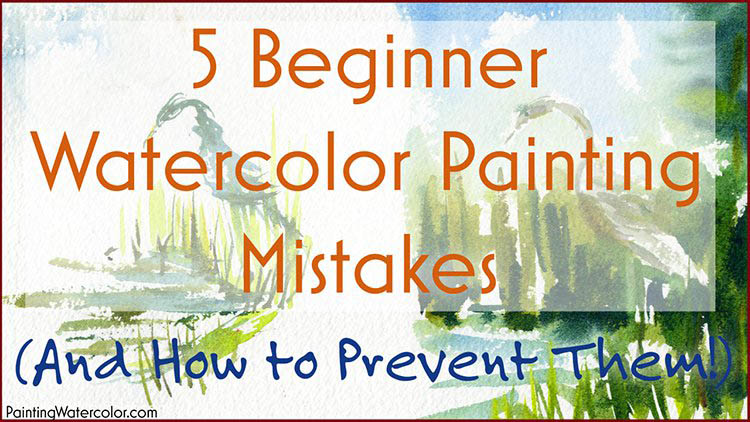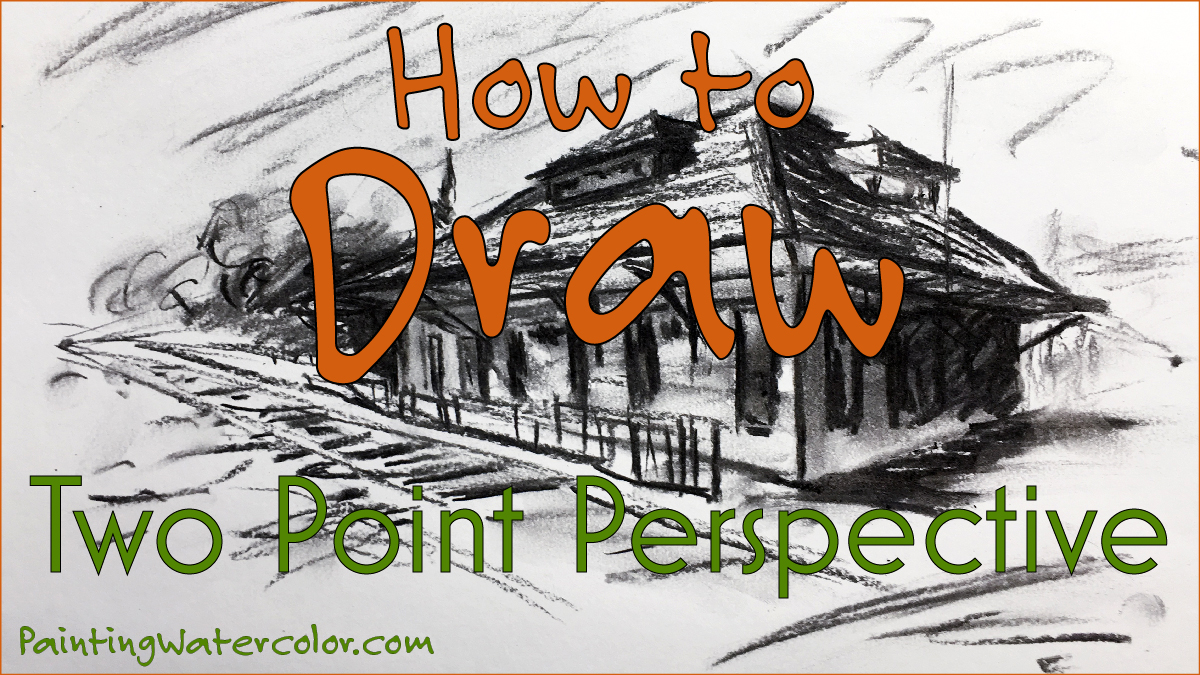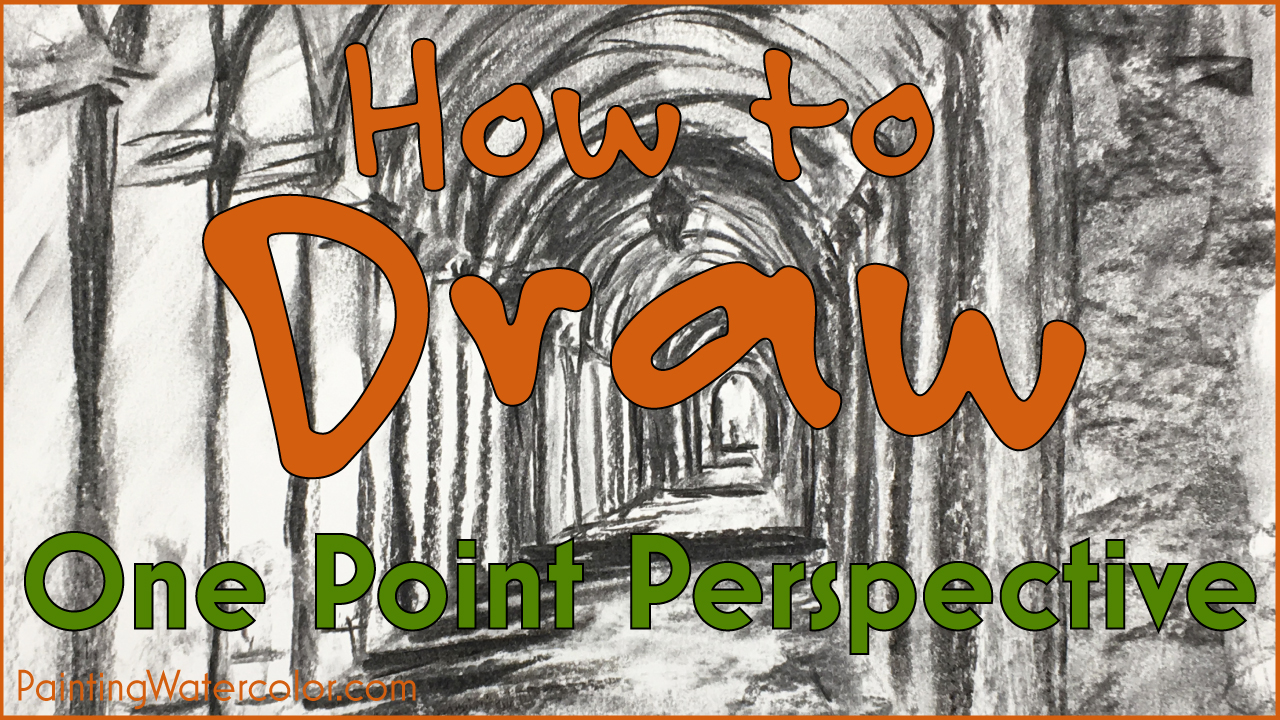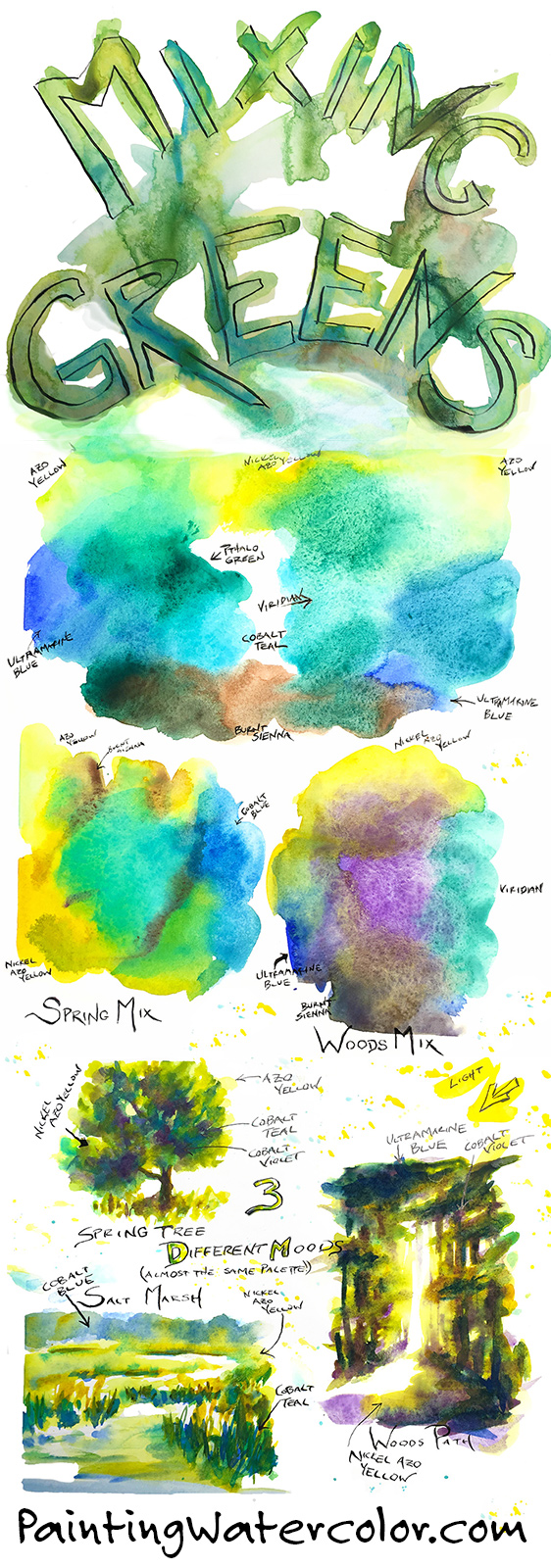Mixing with Single Pigment Greens
The simplest way to paint greens is to use a single pigment color, then vary it with additional colors.
The key here is a SINGLE PIGMENT paint, NOT a premixed combination of pigments, like Sap Green or Hooker's Green.
Sap Green or Hooker's Green look lovely when you first paint them, but you're already starting with 3 different pigments in each tube. Three pigments is the maximum amount of pigments a beginning artist should use in one wash before it turns to mud. So you're limiting your paint mixing to ZERO more pigments before your painting is muddy. Talk about limiting your painting potential!
A very advanced artist can mix more than 3 pigments at once and get beautiful colors. But it's much harder to do than simply limiting your palette to single pigment colors. Why start by crippling yourself?

I use either Pthalocyanine Green or Viridian Green when I want a quick green. I'll only use one of them, so I keep them in the same well on my palette. (I paint almost every day.) They're both a little bright to use without mixing them. Green is the only color I mix on my palette, so sometimes that's where I start mixing. I usually finish mixing on the paper either way.
Pthalocyanine Green
Pthalo Green is very staining, very transparent and very bright. There are no half measures with any of the Pthalocyanines! If you want bright summer greens, Pthalo Green is your best choice!
Viridian Green
Viridian Green is not as staining, slightly grainy and a little duller than Pthalo Green. If you want granulation, Viridian Green is your best choice.
Artist's Tips
Lots of paint AND lots of water make vibrant colors.
Disclaimer: Jennifer Branch Gallery is a participant in the Amazon Services LLC Associates Program, an affiliate advertising program designed to provide a means for sites to earn advertising fees by advertising and linking to amazon.com. I receive a small rebate for your entire order (starting at 4%) if you choose to purchase through Amazon. Most items can be bought multiple places and I highly recommend local art stores if you have one! Any other recommendation links I receive no compensation for.
These referrals help me support this website, and I thank you for any purchase you make through them. I will never recommend a product I have not used frequently and believe is the best tool for the purpose!
Mixing Without Premixed Greens
I prefer to use the single pigment greens as additions to a green mix, rather than the starting point. I'm more inclined to use pthalo or viridian when I'm sketching rather than in my studio.
Usually I start with a basic yellow + blue = green combination, then build from there.
First, think about the mood you want in your painting. Is it soft diffused light or harsh summer sun? Is the color grayed or bright?
Here are 2 examples of green mixes, one spring flowers and one summer shadowed woods.
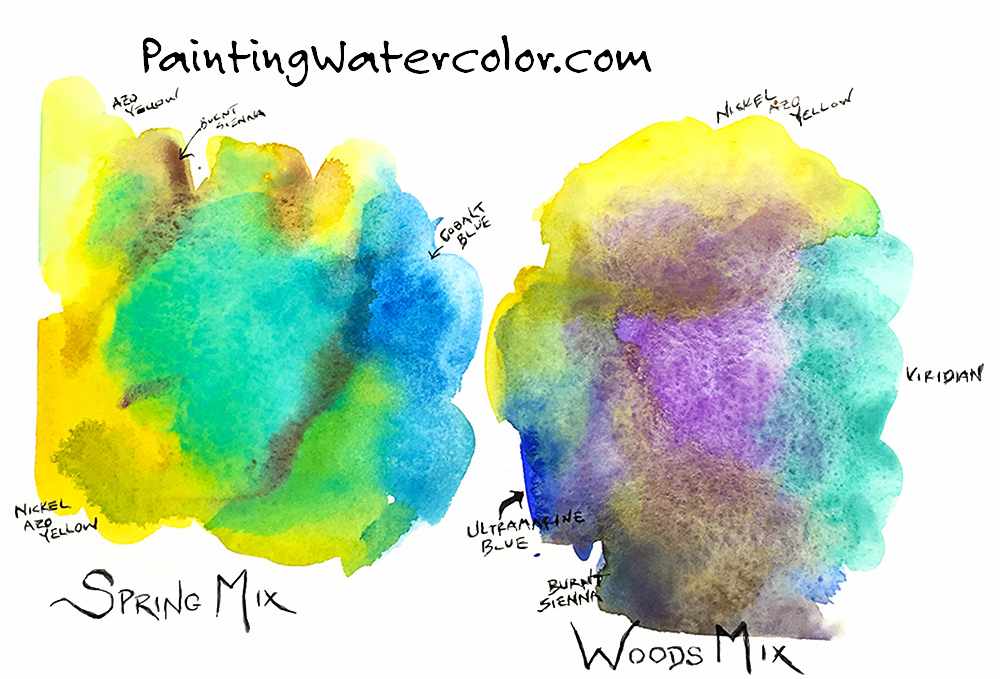
Similar Palette, but Different Greens
How you balance a simple palette has an enormous effect on the mood of your painting, as well as the actual color of the green paint.
Simple Steps to Pigment Choice:
1. Values
Are your values light or dark?
| Light | Dark |
| Good Blues | Cobalt Teal
Cobalt Blue | Ultramarine Blue
Pthalo Blue |
| Good Yellows | Azo Yellow | Nickel Azo Yellow
Burnt Sienna |
| Muting or Dulling Pigments | Nickel Azo Yellow
Cobalt Violet | Maroon Perylene
Cadmium Red |
Are these all the colors you can use? Of course not!
This is just a handy cheatsheet!
2. Cool / Warm
Where is your painting cool colors? Where is it warm colors? Change your green mix to match the tone of the painting!
| Cool | Warm |
| Good Blues | Ultramarine Blue
Cobalt Blue | Cobalt Teal
Pthalo Blue |
| Good Yellows | Azo Yellow
Raw Sienna | Nickel Azo Yellow
Cadmium Yellow |
| Muting or Dulling Pigments | Nickel Azo Yellow
Cobalt Violet | Maroon Perylene
Cadmium Red |
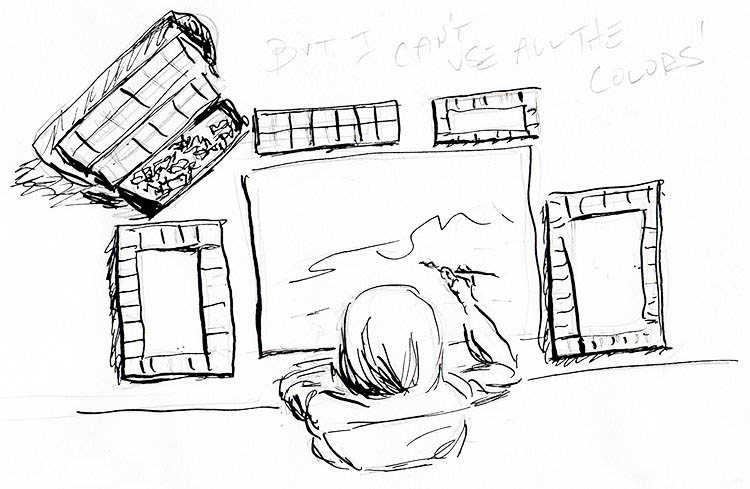
3. Transparent or Opaque?
Are you painting a smooth, glassy sea or the rocky shore?
| Transparent | Opaque |
| Good Blues | Pthalo Blue
| Cobalt Blue
Ultramarine Blue |
| Good Yellows | Azo Yellow
Nickel Azo Yellow | Yellow Ochre
Cadmium Yellow |
| Muting or Dulling Pigments | Maroon Perylene
Cobalt Violet | Burnt Sienna
Cadmium Red |
Remember, it's all relative! One artist's cool, granulating pigment may be another artist's warm, smooth pigment!
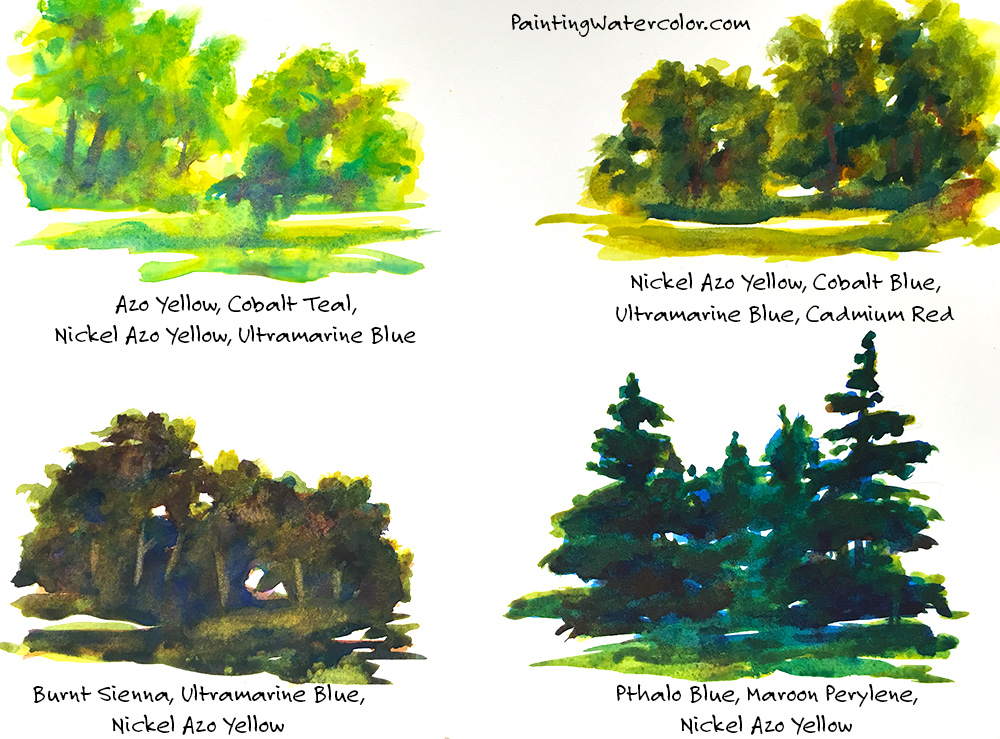
4. Granulating or Smooth?
Do you want interesting textures or a smooth, even wash?
| Smooth | Granulating |
| Good Blues | Pthalo Blue
Cobalt Blue | Cobalt Teal
Ultramarine Blue |
| Good Yellows | Azo Yellow
Nickel Azo Yellow | Yellow Ochre
Cadmium Yellow |
| Muting or Dulling Pigments | Quinacridone Red
Cobalt Violet | Burnt Sienna
Cadmium Red |
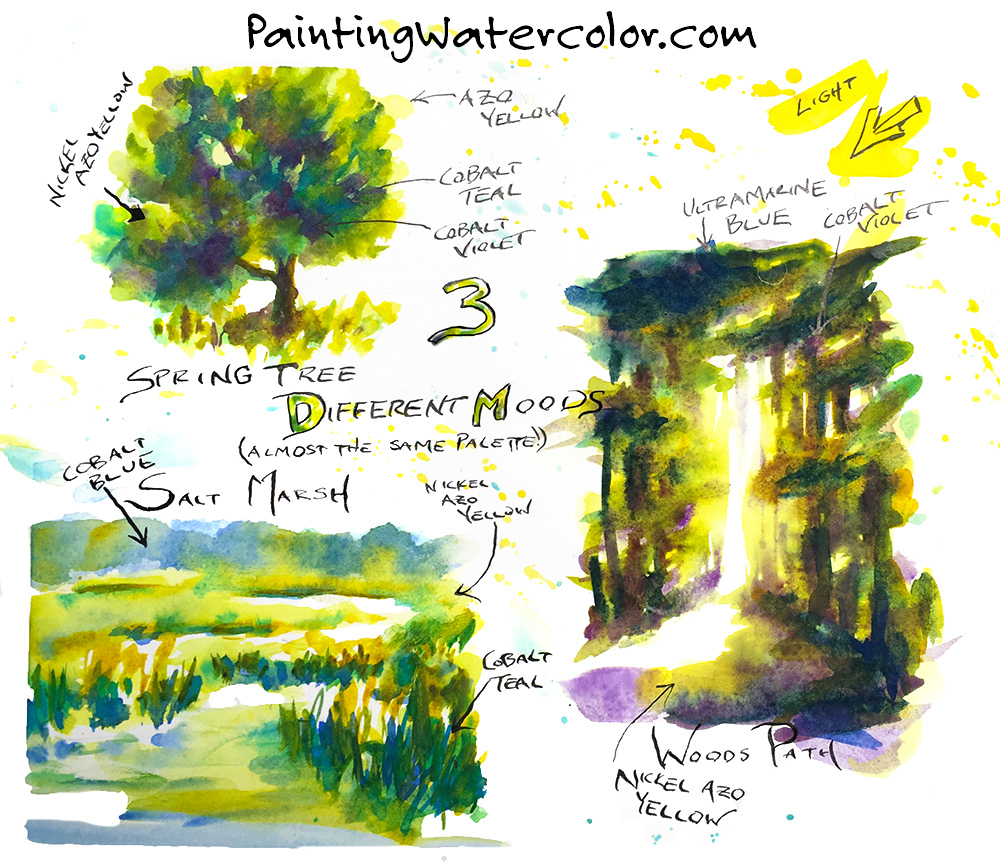
Here are 3 examples using almost the same pigments but resulting in completely different sketches.
I know there are a lot of green pigments to choose from. The choice is almost overwhelming. If you stick to single pigment tubes of color, you'll go a long way towards mixing beautiful greens. Remember the premixed greens are a paint manufacturer deciding warm or cool, granulating or smooth, not you, the artist.
Mix your own beautiful greens and make your paintings glow with life!
Homework!
Using the colors you already own, sort out the single pigment colors.
Make some paint swatches, not just simple dots of color, but big washes - 4" x 4" minimum, mixing 2 other pigments with each "master" color.
See how the pigments work together!
Now put your greens to work!
Paint the same group of trees - just a few blobs will work - no details - at 3 different times of day.
You'll be surprised at how the colors change!







